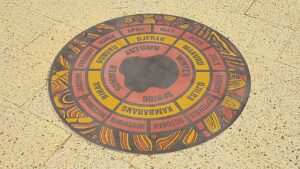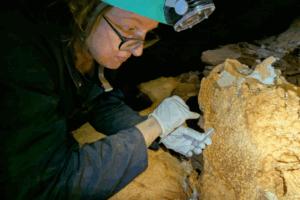In 1971, the Gates of Hell opened in Turkmenistan.
While drilling for natural gas, prospectors uncovered a giant crater that began spewing noxious methane gas.
The prospectors had to think fast to protect the nearby town of Darvaza.
So they set it on fire.
Any methane that seeped out would combust with oxygen gas to form other gases – namely, the much less harmful carbon dioxide (CO2) and water vapour (H2O).
The prospectors thought it would burn out within a week. It still hasn’t stopped.
BURPS AND BUBBLES
Methane comprises one carbon atom surrounded by four hydrogen atoms for a chemical formula of CH4.
As the main component of natural gas, methane can be found in underground caverns like those in Turkmenistan.
It has a few other natural sources too. Methane bubbles up from landfills and wetlands as organic materials decompose.
And there’s methane in cow burps. So many cow burps. Seriously, so much of it is cow burps.
Methane goes bang really easily, with a lot more oomph than almost any other fuel.
That’s why it’s used in energy production and in household appliances, including stoves and heaters.
When methane does go bang, it produces carbon dioxide and water vapour. Both are greenhouse gases.
Caption: Many methane emissions come from cow burps
Credit: Cow (Fleckvieh breed) Oeschinensee Slaunger by Kim Hansen CC BY-SA 3.0
A greenhouse gas that makes greenhouse gas
A greenhouse gas is any gas in the atmosphere that can absorb the radiation emitted from Earth’s surface.
This prevents heat from escaping into space, which warms the planet.
Carbon dioxide and water vapour are both greenhouse gases. But so is methane, and it’s far worse than CO2.
In retrospect, the prospectors near Darvaza didn’t just save the town from suffocating.
They dramatically reduced the methane output of the Gates of Hell.
Limiting our own climate catastrophe
A lot of work is being done to reduce CO2 emissions.
Unfortunately, methane emissions have been largely ignored, as the Climate Council of Australia noted in a recent report.
Fossil fuel companies could eliminate a massive portion of methane emissions if they stopped methane leaking out of their facilities, according to the Climate Council. These preventable fugitive emissions account for one-quarter of Australia’s methane pollution.
Individually, we can reduce our own methane footprints by avoiding gas appliances and sorting our rubbish into the correct bins.
While these small steps aren’t as dramatic as lighting the Gates of Hell, they’re just as important.









